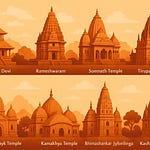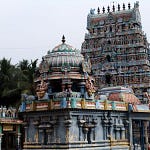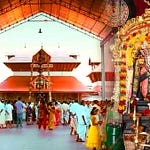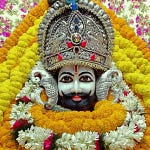Shri Trimbakeshwar Jyotirlinga is one of the twelve sacred Jyotirlingas of Lord Shiva in India. Located in Trimbak town of Nashik district in Maharashtra, this temple holds immense spiritual, religious, and historical significance. It is revered not only for its unique Jyotirlinga form but also as the origin point of the sacred Godavari River, often referred to as the Ganga of the South.
It is dedicated to the Hindu god Shiva and is one of the twelve jyotirlingas where the Hindu genealogy registers at Trimbakeshwar, Maharashtra are kept. The origin of the sacred Godavari River is near Trimbak. Several Hindu rituals are carried out in Trimbakeshwar, for that pilgrims travel from all over India.
Jyotirlingas are sacred shrines of Lord Shiva; it is believed that Lord Shiva himself visited these places and hence they have a special place in the hearts of devotees. There are 12 of them in India.
Jyotirlinga means ‘column or pillar of light’. The ‘stambha’ symbol represents that there is no beginning or end.
When Lord Brahma and Lord Vishnu had an argument about who was the supreme god, Lord Shiva appeared as a column of light and asked each one to find the ends. Neither could do it. It is believed that the places where these columns of light fell is where the jyotirlingas are located.
Trimbakeshwar Jyotirlinga is only one of the 12 jyotirlingas in India that does not only honor Lord Shiva but the other two gods in the Holy Trinity - Lord Vishnu and Lord Brahma as well.
Historical Origin & Timeline The Trimbakeshwar temple has a history dating back thousands of years and is mentioned in several ancient Hindu scriptures including the Shiva Purana and the Skanda Purana. It is believed that Gautam Rishi performed penance here and brought the Ganga down to earth in the form of Godavari. The original temple is said to have existed in the Satya Yuga. The present structure was reconstructed in the 18th century by the Maratha ruler, Peshwa Balaji Baji Rao (Nanasaheb Peshwa).
The entire temple is built with black stone. The main feature of Trimbakeshwar Shiva Temple is that the jyotirlinga has three faces representing the gods - Shiva, Vishnu and Brahma. They all exist within the hollow space within the Shivalinga. Hence the name Trimbakeshwara (Three Lords). They are covered by a jewelled crown that is believed to date to the era of the Pandavas.
You will also find images of Rama, Krishna, Ganga, Parasurama and Kedarnath among others. There are also monasteries of saints in this temple.
The temple has a well called Amritavarshini. It also has a Kushavarta or sacred pond, which is believed to be the source of the Godavari.Timeline Overview:
Satya Yuga: Gautam Rishi's penance and origin of Godavari.
Ancient Period: Temple mentioned in Shiva Purana and Skanda Purana.
18th Century: Temple reconstructed by Peshwa Nanasaheb.
What is the story behind Trimbakeshwar Jyotirlinga?
It is said that Gautama rishi lived on the Brahmagiri hills along with his wife, Ahalya. While there was famine everywhere else on the land, inside the rishi’s ashram, there were abundant food grains. This was because the gods had blessed him because of his steadfast devotion and regular prayers. The other rishis felt jealous of him and sent a cow into his fields.
When Gautama tried to frighten the cow away from his fields, it died. For the sin of killing a cow, Gautama worshipped Lord Shiva to release the Ganga River and let her flow into his ashram to purify it. Pleased with his devotion, Lord Shiva released Ganga and told her to stay there. The Kushavarta or sacred pond that exists now is the source of the Godavari. (People worship the Godavari as Ganga.) The sage requested Lord Shiva also to make the site his abode, which the Lord did in the form of the jyotirlinga.
Architectural Grandeur The temple is built using black basalt stone in the Hemadpanthi architectural style. It features a grand shikhara (tower), intricate carvings, and delicate motifs of floral and geometrical patterns. The sanctum houses a singular Jyotirlinga with three faces symbolizing Lord Brahma, Lord Vishnu, and Lord Mahesh (Shiva) – a unique feature not seen in other Jyotirlingas.
The temple also has a sacred pond called Kushavarta Kund, which is considered the source of the river Godavari.
Spiritual & Religious Essence Shri Trimbakeshwar is not just a temple; it's a living representation of the Trimurti (Brahma, Vishnu, Shiva). The Jyotirlinga itself is eroding due to constant water abhishek, symbolizing the natural cycle of creation, preservation, and destruction.
This is the only Jyotirlinga where the lingam is not a protruding stone but a depression in the floor. The belief is that Lord Shiva resides here eternally with Lord Vishnu and Lord Brahma.
Rituals & Pujas The temple is famous for:
Rudra Abhishek: Performed daily with water, milk, and bilva leaves.
Kaal Sarp Dosh Puja
Narayan Nagbali
Tripindi Shraddha
Maha Rudrabhishek These rituals are believed to eliminate various doshas (afflictions) and provide peace, prosperity, and liberation.
Festivals & Celebrations
Mahashivratri: The most celebrated festival with grand processions and all-night Jagran.
Kumbh Mela: Occurs once every 12 years. Trimbak is one of the four places where the Kumbh Mela is held.
Shravan Maas: A month dedicated to Lord Shiva sees thousands of devotees performing special pujas.
Next Kumbh Mela in Trimbak: Expected in 2030-31 (based on the 12-year cycle after the 2015 Kumbh).
Travel Guide
Nearest Airport: Nashik (30 km), Mumbai (200 km)
Nearest Railway Station: Nashik Road (28 km)
Road Connectivity: Well-connected by buses and taxis from Mumbai, Pune, Shirdi, and Nashik.
Best Time to Visit
Monsoon (July–September): Lush greenery and vibrant water bodies.
Winter (October–February): Pleasant weather for pilgrimage and sightseeing.
Aarti Timings
Morning Aarti: 5:30 AM – 6:30 AM
Rudrabhishek Puja: 7:00 AM – 9:00 AM
Maha Aarti: 7:00 PM
Temple Closes: 9:00 PM
Sacred Sloka “Trimbakam yajamahe sugandhim pushtivardhanam | Urvarukamiva bandhanan mrityor mukshiya maamritat ||”
(From the Maha Mrityunjaya Mantra - A powerful mantra for healing and liberation)
Popular Bhajan “Om Namah Shivaya Har Har Bholenath Trimbakeshwar Dham mein Jeevan paayein saarthak raath”
Why Every Devotee Must Visit
One of the rare temples where Trimurti is worshipped together.
Eroding Jyotirlinga shows the cosmic truth of impermanence.
Holy origin of Godavari River.
Powerful pujas for dosha nivaran and spiritual growth.
Connection with Kumbh Mela and Vedic heritage.
A visit to Shri Trimbakeshwar is not just a pilgrimage; it is a spiritual transformation.
Shri Trimbakeshwar Jyotirlinga stands as a testament to India’s deep-rooted spiritual legacy. It is a confluence of mythological depth, architectural brilliance, and divine energy. Whether for spiritual upliftment, ritualistic purposes, or simply seeking peace, this sacred abode of Lord Shiva offers solace to every soul who walks its path.











